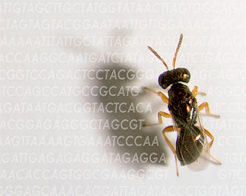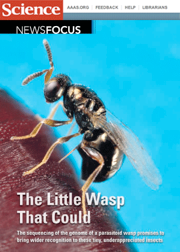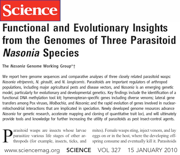Nasonia has now entered the genomics era with sequencing of the genomes of three species (N. vitripennis, N. giraulti, and N. longicornis), reported in Science and two additional species on the way (N. oneida and Trichomalopsis sarcophagae). These genomes rapidly advance Nasonia as a model genetic system, particularly for evolutionary genetics, developmental genetics and the identification of genes involved in complex genetic traits. The first identification of a quantitative trait locus (QTL) in Nasonia has just been published in PLoS Genetics, and reveals that non-coding DNA adjacent to the sex determining locus doublesex is responsible for a large recently evolved and sex-specific difference in wing size between the species.
In total, 29 companion papers are being co-released with the Nasonia genome paper reporting on topics ranging from new genetic and genomic tools, to QTL involved in species differences and hybrid incompatibilities, comparative genomics of biologically interesting gene families and to the other sequenced Hymenopteran the Honeybee.
Students and researchers interested in learning more about the Nasonia genome or working on this system should contact Jack Werren.
The Nasonia Genome paper has been published:
Werren, J.H., S. Richards, C.A. Desjardins, O. Niehuis, J. Gadau, J.K. Colbourne, et al. 2010. Functional and evolutionary insights from the genomes of three parasitoid Nasonia species. Science: 327(5963)343 - 348.
See also the News Focus story by Elizabeth Pennisi “The Little Wasp That Could.” and “Parasitic wasps' DNA laid bare” in Nature.
Key points of Genome Paper
-
•Nasonia has a complex venom repertoire with many previously unknown proteins that could be useful in pest control and drug development.
-
•Nasonia has a complete methylaton toolkit and DNA methylation, a genetic modification involved in gene regulation in humans and other vertebrates, but absent in the standard insect model Drosophila.
-
•Nasonia mitochondrial DNA evolves very quickly, and nuclear genes for proteins in the mitochondria also evolve quickly. These coadapting gene sets appear to be involved for genetic incompatibilities in hybrids
-
•Nasonia has acquired and uses genes from bacteria and pox viruses. The function of these genes in Nasonia is not yet known, but acquisition of genes from bacteria and viruses could be an important mechanisms for evolutionary innovation in animals, and this is a striking potential example.
-
•The genome sequences now provide a set of genetic tools for efficient identification of genes involved in complex genetic traits (known as quantitative trait loci or QTL). Several QTL are being mapped and identified, including those affecting host choice, mating behavior and mate choice, and sex determination.
-
•A long term goal is to genetically modify parasitoids through selective breeding to improve their utility in pest control. The genome sequences provide tools and baseline information towards achieving this goal.
Nasonia Genome Resources:
The Center for Genomics and Bioinformatics - Indiana University
Nasonia vitripennis Empirical Genome Annotation - Baylor college of Medicine








